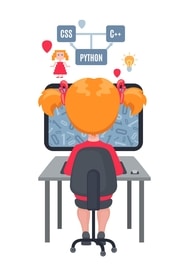How to Teach Kids How to Code Without All The Tech Jargon
Coding for kids is never an easy undertaking. Aside from getting our kid’s full attention, we have to overcome communication barriers and teach complex lines of codes in the simplest way possible. We need to think outside the box so that we can get our kids excited about coding.
That being said, we have listed a few tips on how you can teach your kids how to code without all the tech jargons.
Make them interested
One of the most common mistakes that educators and parents often make is that they immediately jump to teaching the basics and fundamentals. While these information are crucial when it comes to learning how to code, it does not give our kids enough room to process and absorb all the information that they are receiving.
Remember that learning is an academic, social, and emotional undertaking. Studies have shown that kids are more inclined to learn more about the subject if they are interested. With that in mind, you need to make them interested in coding first. This way, they would not only learn how to code, but they would also learn to love the subject and even the learning process.
Teach the Basics Differently
You can do away with the tech jargon if you are just teaching them the basics and fundamentals of coding. If your kids are just starting in their learning journey, then you can simply find alternative ways to teach them the basics and make them excited to learn more about coding.
Many coding for kids programs and courses have already cracked the secret to teaching kids how to code. Nowadays, teaching is no longer confined to the traditional approach like reading from a textbook or printing outputs like “Hello, World!”
There are now several coding apps, games, video explainers, computer programs, software, toys, and other educational materials that you can use to teach your kids.
Block-based coding
Once your kids finish learning all the basics and fundamentals of coding, it is time to start developing their critical and computational thinking. You can do this by simply utilizing programs like Scratch or Blockly.
These blocked-based programs are the most effective and convenient way to teach your kids how coding works. Rather than having them memorize lines of codes or understand complex syntax, you can just use programs like Scratch or Blockly.
To give you an overview of block-based programming, Scratch or Blockly lets you drag-and-drop lines of commands without having to type or memorize the codes. Your kids can create their own games or apps in these programs even though they do not know any single line of code.
Therefore, your kid can easily learn syntax and conditionals without you detailing or explaining tech jargon like assignment operators, loops, functions, if statements, and so on.
Physical and relatable concepts
No matter how long you put off or avoid using tech jargon, there will still come a time when you have to explain these complex matters to your kids.
And when that time comes, you can still be an effective teacher.
This video explainer from the University of South California’s website is the perfect illustration of teaching complex concepts with relatable examples. Rather than simply read off of a textbook and discuss branching, variable review, or python syntax basics, they instead use relatable examples like text messaging, lunch menus, and food groups.
Even though they tackled coding concepts and other complex subjects, they still managed to convey the information in a much simpler and easy-to-understand form. By doing this, your kid would be able to start learning a more specific and complex coding language in no time.
Fun Projects
Learning how to code is a continuous undertaking and has many benefits outside life of coding. Keep in mind that learning does not stop at the end of every lecture or session. Kids should be able to use and apply the information they learned.
One study even found that students prefer active learning over the traditional learning approach when it comes to programming. That said, kids learn better when the approach is more engaging and interesting. And what better way to do this than through fun projects.
These fun projects can be anything. You can assign them projects like making simple cartoon animations, Roblox games, Minecraft mods, and so on. The key thing to remember when assigning projects is to consider their existing interests as well. If your kids love playing Minecraft, then their next project can be about Minecraft mod or shaders.
Think of a project that would not only help them learn but would also pander to their interests.
Build on Success
Part of the learning journey is failure. It’s one of the biggest obstacles to learn coding for kids. It is also one of the reasons why kids often lose interest or quit halfway in their learning journey.
So to overcome this hurdle, you should celebrate their achievement and find ways to extend that achievement even further. For example, if your kid finally learned how to use programming tools like Scratch, then you can share their finished project online for their friends to see. Doing this would boost their confidence and push them to learn more complicated projects in the future.
Just Have Fun with Them
Even though coding is a complicated subject to teach, you can make learning the coding process even more bearable for your kids. Inspire your kids to learn more through play.
Given that the learning process can be long and tedious, you should find ways to make the learning journey a lot more fun and exciting.
This way, your kids would be able to understand all the tech and coding jargons in no time.




